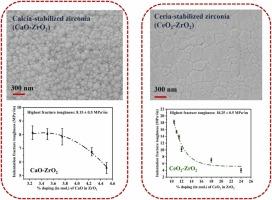随着掺杂浓度的增加,稳定氧化锆陶瓷断裂韧性的一致性研究
IF 6.3
2区 材料科学
Q2 CHEMISTRY, PHYSICAL
引用次数: 0
摘要
这项工作提出了一个系统的研究趋势和压痕韧性和掺杂剂浓度之间的关系在稳定的氧化锆陶瓷(钙,钇,和铈稳定)。讨论了掺杂剂浓度对氧化锆陶瓷力学性能的影响,重点讨论了通过稳定相和控制晶粒尺寸来优化断裂韧性。研究了三种掺杂体系,如钇(2-4摩尔%)、钙(3.25-4.5摩尔%)和铈(10-12摩尔%)。断裂韧性(KIC)采用维氏压痕断裂(VIF)法测定,并通过Palmqvist裂纹的Niihara方程计算。考虑氧化钇稳定(YSZ)和钙稳定(CaSZ)氧化锆的弹性模量为210 GPa,氧化铈稳定的四方氧化锆多晶(Ce-TZP)陶瓷的弹性模量为190 GPa。对CaSZ陶瓷的研究表明,在3.25、3.5和3.75 mol.%的掺杂浓度下,CaSZ陶瓷的韧性值保持不变,这与氧化锆陶瓷韧性数据的传统趋势形成了对比。随着掺杂水平的增加,YSZ和Ce-TZP稳定的氧化锆陶瓷的四方相和韧性显著降低,而CaSZ保持了四方相,结构畸变最小。此外,10.5% Ce-TZP的断裂韧性达到了~19 MPa / m,超过了常规基准。CaSZ陶瓷的微观结构非常精细,晶粒尺寸在100 nm左右。韧性值随掺杂浓度的降低与许多因素有关,如晶粒尺寸、四方性的降低、较软的t '相的出现等。本文章由计算机程序翻译,如有差异,请以英文原文为准。

Exploring the consistency of fracture toughness in stabilised zirconia ceramics with progressive dopant concentrations
This work presents a systematic study of the trend and relationship between indentation toughness and dopant concentrations in stabilised zirconia ceramics (calcia, yttria, and ceria stabilized). Influence of dopant concentrations on the mechanical properties of zirconia ceramics, focusing on optimizing fracture toughness through phase stabilization and grain size control has been discussed. Three dopant systems, e.g., yttria (2–4 mol.%), calcia (3.25–4.5 mol.%), and ceria (10–12 mol.%) were explored. Fracture toughness (KIC) was determined using the Vickers Indentation Fracture (VIF) method and calculated through the Niihara equation for Palmqvist cracks. Elastic modulus values of 210 GPa for yttria-stabilized (YSZ) and calcia-stabilized (CaSZ) zirconia, and 190 GPa for ceria-stabilized tetragonal zirconia polycrystal (Ce-TZP) ceramics were considered. Studies with CaSZ ceramics revealed that toughness values remained unchanged across doping concentrations of 3.25, 3.5, and 3.75 mol.%, in contrast to traditional trends of toughness data in zirconia ceramics. The YSZ and Ce-TZP stabilized zirconia ceramics showed significant reductions in tetragonality and toughness with increasing doping levels, while CaSZ retained the tetragonal phase with minimal structural distortion. Additionally, 10.5 mol% Ce-TZP exhibited exceptional fracture toughness of ∼19 MPa√m, surpassing conventional benchmarks. CaSZ ceramic displayed a very fine microstructure with grain size in the range of 100 nm. The degradation of toughness values with doping concentration was correlated to numerous factors, e.g., grain size, reduction in tetragonality, appearance of a softer t’ phase etc.
求助全文
通过发布文献求助,成功后即可免费获取论文全文。
去求助
来源期刊

Journal of Alloys and Compounds
工程技术-材料科学:综合
CiteScore
11.10
自引率
14.50%
发文量
5146
审稿时长
67 days
期刊介绍:
The Journal of Alloys and Compounds is intended to serve as an international medium for the publication of work on solid materials comprising compounds as well as alloys. Its great strength lies in the diversity of discipline which it encompasses, drawing together results from materials science, solid-state chemistry and physics.
 求助内容:
求助内容: 应助结果提醒方式:
应助结果提醒方式:


